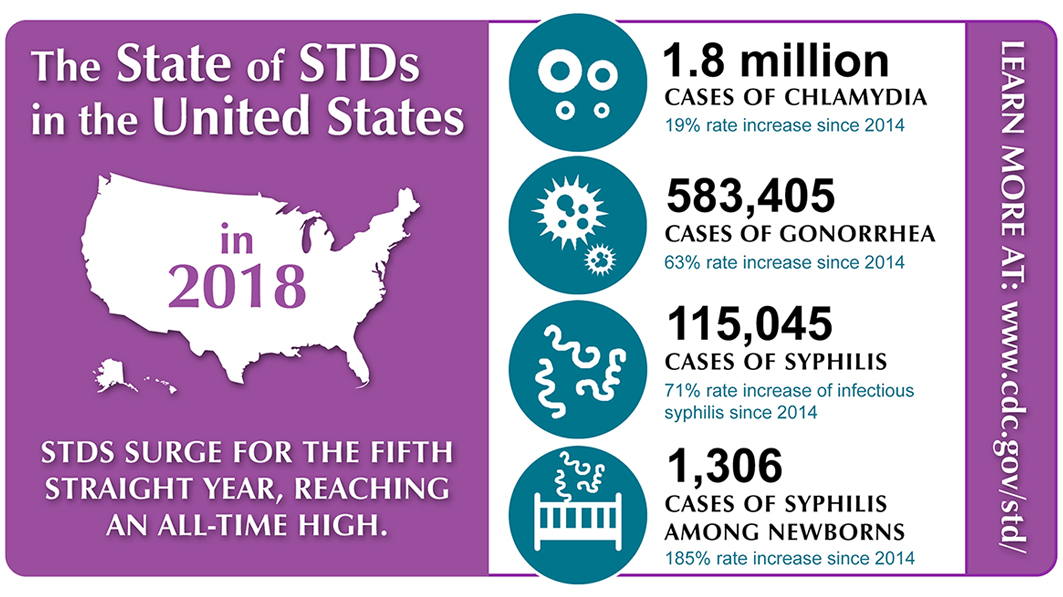A new report from the U.S. Centers for Disease Control and Prevention (CDC) announced that sexually transmitted diseases (STDs) reached an all-time high in 2018. The CDC released the Sexually Transmitted Disease Surveillance Report, 2018, showing increases for the three most common STDs – chlamydia, gonorrhea and syphilis – for the fifth straight year.
The Surveillance Report showed more than 115,000 cases of syphilis and more than 580,000 cases of gonorrhea, the highest numbers since 1991. It also showed more than 1.7 million cases of chlamydia, the most ever reported to the CDC, and an increase of 3% over the previous year. Overall there are 20 million new sexually transmitted infections in the U.S. each year.
The CDC also spotlighted a 40% increase in newborns with congenital syphilis, occurring when the disease is passed from mother to child during pregnancy. In 2018 there were 1,306 cases of congenital syphilis, a 185% increase since 2014. Congenital syphilis caused 94 infant deaths last year.
Dr. Gail Bolan is Director of the CDC’s Division of STD Prevention. In a letter announcing the release of the Surveillance Report, she said, “In addition to newborn death, congenital syphilis can result in miscarriage or severe lifelong physical and neurological problems for the child.” She also stressed that these infants lost their lives to a preventable infection.
The groups most affected by STDs are young people, men who have sex with men and pregnant women. The CDC estimates that youth ages 15-24 account for half of the 20 million new infections, while men who have sex with men (MSM – the CDC’s term) are at greater risk for contracting STDs. More than half of all HIV infections occur among this group. Because many STDs have no symptoms, the CDC encourages pregnant women to get tested – for their own sake and that of their child.
“Antibiotics can cure syphilis, gonorrhea, and chlamydia,” the CDC news release stated. But it also catalogued the cost when STDs are untreated, such as infertility, ectopic pregnancy, chronic pelvic pain, increased HIV risk and infant death.
Dr. Bolan, writing in the Surveillance Report, notes that “not that long ago, gonorrhea rates were at historic lows, syphilis was close to elimination, and we were able to point to advances in STD prevention, such as better chlamydia diagnostic tests and more screening, contributing to increases in detection and treatment of chlamydial infections. That progress has since unraveled.”
The CDC and Dr. Bolan list numerous factors driving the surge in STDs, including: “a deteriorating public health infrastructure and lack of access to health care”; “drug use, poverty, stigma, and unstable housing”; state and local government cuts to STD programs; and decreased condom use by young people and MSM.
Neither mentioned, though I searched in their statements and reports, that there might be other cultural factors driving this resurgence. These would include factors such as: the breakdown of the family and absence of fathers from children’s lives; media and entertainment that depict sexual activity but rarely show the emotional or physical consequences; sexualization of children in education; the “hookup culture” on some college campuses; and the rampant availability and use of pornography.
Nor did they mention that these rising rates are more evidence of the malignant consequences of the “sexual revolution” which normalized divorce, cohabitation and sex outside of marriage.
As sad as this report is, it provides opportunities for Christians. First, we can point to the goodness of God’s design for relationships, marriage, family and sexuality. And we can demonstrate this goodness, with His empowerment, in our own lives. Second, it’s a reminder to parents to teach their children about God’s plan for these key areas of life.
More resources:
How to Teach Your Children About Marriage: Creative and Practical Ideas
From toddlers to teenagers, this resource includes practical suggestions for equipping your kids to understand what marriage is and why it is so vitally important.
Launch into the Teen Years – Focus on the Family’s new video curriculum helps you and your preteen communicate openly while digging into the truths about dating, sex and the challenges of the adolescent years.
The Talk: Healthy Sexuality Education — Basic Goals and Guidance from Focus on the Family
Created by Focus on the Family’s counseling staff, this free guide helps parents educate their children about sexuality. It explains the biblical and spiritual significance of marriage and sexuality and gives practical objectives and methods for talking with children of all ages.
Photo from the CDC






